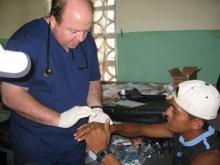After more than a decade of operating a solo medical practice in Mendon, Ohio, Dr. Cal Morris was able to retire in 1998 and take his medical career in a new direction – south to Central America, to provide medical care for the Ngöbe people in a remote region of Panama. Dr. Morris earned his medical degree at the University of Cincinnati College of Medicine in 1982 and completed his internal medicine residency at the Good Samaritan Hospital in Cincinnati.
What first inspired you to go to Panama?
A few years after closing my office, I wanted to give something back. Pardon the cliche, but mission work was something I had been called to do. When I had a solo practice, time off was rare, so mission work was simply out of the question while I maintained that practice. I had an early opportunity to leave practice, so I took it and started preparing for mission work.
After a lot of study I chose Panama. A new health care team was forming through the Volunteers in Mission program, which operates under the auspices of the United Methodist Church, and they needed a second doctor for the team. The need is great in Panama, and it is relatively accessible from the United States.
Have you returned to the same location each visit?
We climbed a steep learning curve that first year. The entire team was new, so we were all feeling our way. At the end of the first trip, we took a vote and decided to return to the same location. The second trip was transformative. The lessons we learned from the first trip made us much more effective and cost effective. Both the Ngöbe people and our team benefited greatly. I have returned to the same location every year, and twice a year when I can.
What were some of the challenges and lessons learned about practicing medicine overseas, compared with the United States?
One of the harder lessons we learned was how to work with translators in Panama. My Spanish is good enough to fake it in a restaurant, but not good enough to be effective for rendering medical care. Many of the Ngöbe do not speak Spanish, so we need two translators much of the time – for English to Spanish, and from Spanish to Ngöbe, and back again. The hard lesson was that in addition to crossing two languages, we are also practicing across two sets of very different cultures – from 21st-century American sensibilities through Third World Spanish perspectives into the Ngöbe world, which is best described as late Neolithic. Theirs is a world filled with spells and demons, spirits and curses. Many turn to a curandero (a form of folk healer or witch doctor) for care. In some cases, clinically depressed patients believe that they are under a spell. Back home I would have started an SSRI and arranged at least counseling, if not a full psychiatric consultation. That is simply impossible in the Ngöbe nation.
Other obvious challenges include the lack of specialist support and the absence of any modern lab and diagnostic equipment. For example, we have considered taking an EKG machine, but it would consume many precious pounds of luggage, and if an EKG for a patient was abnormal, there would be nothing we could do about it. I am in the process of buying a GE Vscan ultrasound scanner, which is small and light enough to be worth hauling to Panama. I can’t wait to start training with it.
What other primitive treatments are common in this area?
What the local healers will often do is take a nail that has been heated in the campfire and inscribe a pattern around the affected area, whether it is the knee, hand, or abdomen. We see a lot of these marks around the abdomen as an effort to treat chronic abdominal pain. Usually, there is no infection from this. The marks are small, and the nail is sterile because it has been in the fire.
What are some of the treatments that you rely on?
In the Ngöbe culture, if people don’t work, they don’t eat, so they push themselves to degrees that we simply don’t see in the United States. As a result, there are many repetitive stress injuries. Many of the women support themselves by weaving, and men spend hours doing machete work in the sugarcane and pineapple fields.

